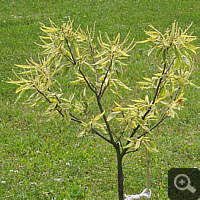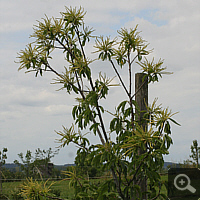Sweet Chestnut (Castanea sativa)
Overview
The Sweet Chestnut tree originates in the Mediterranean region but is long-established in Germany. The tree supplies the edible sweet chestnuts in autumn. The Chestnut tree has also a high adornment value. This deciduous tree from the Beech family (Fagaceae) grows pyramidal at first, only in old age it evolves a sprawling crown. Apart from the wild form it also exists a cultivated form ‚Variegata‘ with white-green piebald leaves.
Description
The tree can reach a height of 20 metres and has a highly developed root system. It has relative large, finely dentate, dark green leaves. The fruits show also a high adornment value. Two to three cores are enfolded by a spiky skin. The tree is monoecious dioecious. The male inflorescences appear circa one week before the female ones. Insemination occurs by wind pollination. Partly Sweet Chestnuts are described as self-fertile.
Culture
The frost tolerance of chestnuts is excellent. A slight acidic soil is preferred. For insemination it is almost inevitable to have planted not less than two trees. On the one hand is partly described a self-infecundity. On the other hand exists a temporal divergence between the opening of the male and female flowers, so that this must be compensated by cross-fertilisation through wind pollination of several specimens.
Experiences
2009
In Summer 2009 I planted a circa two metres high specimen of the wild form and a circa 50 centimetres high specimen of the cultivated form ‚Variegata‘.
2010
Both specimens survived unscathed winter without any special protection and blossomed in spring. The greater one got circa two dozen fruits, which were only undeveloped „pseudo-„fruits due to self-fertilisation thus. Because of dryness growth was rather minor this year. It amounted to 10 centimetres.
2011
Again, winter was well survived without any protection. The late frost period in early May caused only slight damage. The ‚Variegata‘ is well-rooted and blossoms rich. It shows a hugely satisfying growth too. The wild form stands on a heaped hill and suffers from dryness. Only regular watering saves leaves from withering. However, watering is not sufficient for a significant growth.


